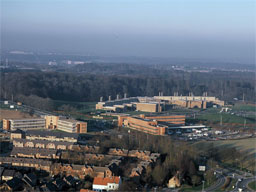A new town (or a planned city) is a specific type of a community that was carefully designed from its inception and is typically constructed in a previously undeveloped area. This contrasts with settlements that evolve in a more ad hoc fashion. Land use conflicts are uncommon in new towns.
Several of the world’s capital cities are planned cities, including Washington, D.C., in the United States, Canberra in Australia, Brasília in Brazil, Belmopan in Belize, New Delhi in India, Abuja in Nigeria, Islamabad in Pakistan and Astana in Kazakhstan.
Modern urban planning dates from the 1850s and the contrasting projects to update Paris. In 1852, Baron Georges-Eugène Haussmann was commissioned to remodel the Medieval street plan of Paris by demolishing swathes of the old city and laying out wide boulevards, extending outwards beyond the old city limits. Haussmann’s project encompassed all aspects of urban planning, both in the centre of Paris and in the surrounding districts, with regulations imposed on building facades, public parks, sewers and water works, city facilities, and public monuments. Beyond aesthetic and sanitary considerations, the wide thoroughfares facilitated troop movement and policing.
In the developed countries of Western Europe, North America, Japan, and Australasia, planning and architecture can be said to have gone through various paradigms or stages of consensus in the last 200 years. Firstly, there was the industrialised city of the 19th century, where building was largely controlled by businesses and wealthy elites. Around 1900, a movement began for providing citizens, especially factory workers, with healthier environments. The concept of the garden city arose and several model towns were built, such as Letchworth and Welwyn Garden City in Hertfordshire, UK, the world’s first garden cities. These were small in size, typically providing for a few thousand residents.
In the 1920s, the ideas of modernism began to surface in urban planning. Based on the ideas of Le Corbusier and using new skyscraper-building techniques, the modernist city stood for the elimination of disorder, congestion, and the small scale, replacing them with pre-planned and widely spaced freeways and tower blocks set within gardens. There were plans for large-scale rebuilding of cities in this era, such as the Plan Voisin (based on Le Corbusier’s Ville Contemporaine), which proposed clearing and rebuilding most of central Paris. No large-scale plans were implemented until after World War II, however. Throughout the late 1940s and 1950s, housing shortages caused by wartime destruction led many cities to subsidize housing blocks. Planners used the opportunity to implement the modernist ideal of towers surrounded by gardens. The most prominent example of an entire modernist city is Brasilia in Brazil, constructed between 1956 and 1960.
By the late 1960s and early 1970s, many planners felt that modernism’s clean lines and lack of human scale sapped vitality from the community, blaming them for high crime rates and social problems. Modernist planning fell into decline in the 1970s when the construction of cheap, uniform tower blocks ended in most countries, such as Britain and France. Since then many have been demolished and replaced by other housing types. Rather than attempting to eliminate all disorder, planning now concentrates on individualism and diversity in society and the economy; this is the post-modernist era.

